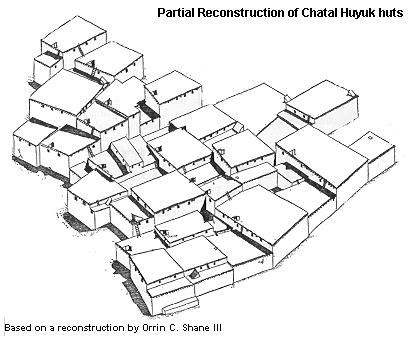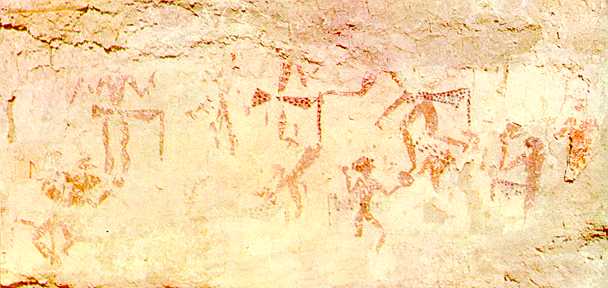 Room 5
Room 5
Human Prehistory: An Exhibition
THE FIRST VILLAGES
After 10.000 BC humans settled down in villages. One of the best preserved is the Neolithic village at Chatal Huyuk in Anatolia (now modern Turkey). The partial reconstruction of the village gives an idea of buildings.
The village of Chatal
Huyuk is the largest Neolithic site in the Near East
covering 13 hectares. It was founded in c.7000 BC and the settlement
grew rapidly and became a prosperous and well-organized community.
The inhabitants of Chatal Huyuk grew mainly wheat, barley and peas.
They supplemented their diet by apples, hackberries,
almonds and acorns, which were collected locally. The
principal meat source was cattle although it seems that wild
animals were also important, judging from the wall paintings portraying
the hunting of red deer, boar and
onagers.
Most raw materials had to be
imported and the village became the center of a trading
complex, dealing in a wide range of items - timber,
obsidian, flint, copper, shells. The craftsmen produced mainly arrowheads,
daggers of flint and obsidian, stone maceheads, baked
clay and carved stone figurines, textiles, wooden vessels
and pottery. Trinkets such as copper heads and
lead pendants were also produced, and copper-smelting.
The houses at Chatal Huyuk were closely packed
together, without intervening streets.
Access to the interiors was by wooden ladder from the flat
roofs. The houses were built of mad-brick and had several rooms the biggest of which was c. 4x5m.
The main room contained benches and platforms
for sitting and sleeping. Life expectancy was short; an average of 34 years for men, 29
for women.
Many features of Chatal Huyuk are puzzling. However,
although we do not know much of this neolithic village's
political and social development, it serves as a
vivid illustration of the huge new potential offered by the
adoption of agriculture in the Ancient Near East. {Source: Past Worlds, The Times Atlas of Archaeology (N. York: Crescent Books, 1995), pp. 82-83.
Walk to Room 6 
Walk back to Room 4
D. I. Loizos, 1996-2003







